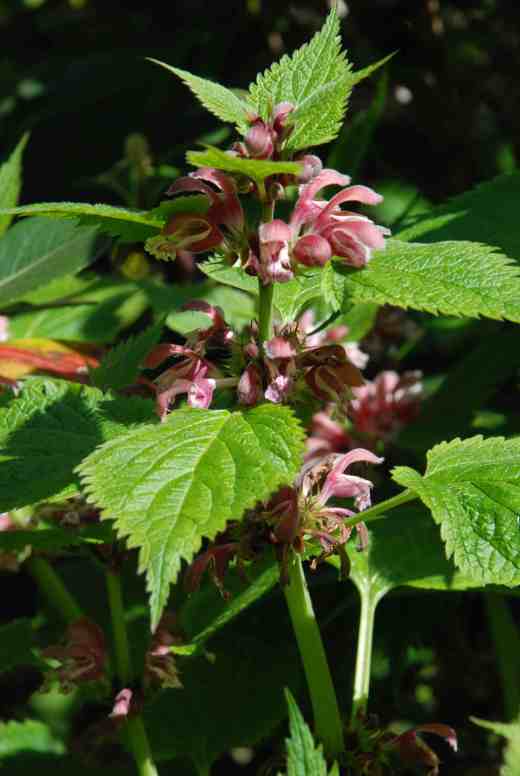Lamium maculatum ‘Beacon Silver’
It is easy to take some plants for granted and lamiums fit neatly into this category. They are lowly in stature and most gardeners do not get very excited about them – some even consider them little more than weeds. In fact, two species are quite common weeds; Lamium album the white deadnettle and Lamium purpureum the red deadnettle. Lamium album is a coarse, wide-spreading perennial with white flowers in early summer. It grows from quite small bits left in the ground and needs to be dug up rather than just pulled and it is a tenacious brute. But, like all the lamiums, the flowers are pretty and abundant and are superb for bumblebees. Lamiums have small, tubular flowers with a hood protecting the stamens and pollen and a large landing pad for the bees to straddle as they crawl into the flowers to get to the nectar. Lamium purpureum is a smaller, more delicate plant and an annual that can also overwinter and act as a biennial. The leaves are rounder and less nettle-like and the blooms are also smaller but just as good for bees. The flowers of all lamiums are rich in nectar and you can test this if you pull a bloom from the calyx and suck the base.
Although there are about 40 species of lamium, some are truly weedy and others are alpines that need careful cultivation. All have whorls (rings) of tubular flowers and the opposite leaves and square (in cross section) stems so typical of the family (Lamiaceae – formerly Labiatae). If you want a classy but robust perennial for a shady spot then look out for Lamium orvala. Like most lamiums, this is a native of Europe, but unlike most it does not creep along the ground but stands upright, forming a leafy clump with large pinkish purple flowers in whorls along the stout stems. There is a white form too which is equally nice. It may self seed if it is happy but is rarely a nuisance. It is best in moist soil in light shade but once established it can withstand drought.
Lamium maculatum is the most commonly seen species and the wild plant has pinkish blooms and leaves with a silver stripe through the centre. It is not surprising that such a common plant had produced a fair number of variations and there are about 50 cultivars listed. It is difficult to pick a favourite but I always used to love the delicate shades of ‘Salmoneum’ though I don’t grow it at present. The cultivars with silvery leaves tend to be the most popular at the moment because of the obsession with colourful foliage and my favourite of these is ‘White Nancy’ because of the purity of the white flowers and silver foliage. But I have just produced a batch of ‘Beacon Silver’ which is going to be used around the garden in shady areas. This popular cultivar was introduced by the great Beth Chatto in 1976 who received it from a customer. It is typically low and neat, only 10cm high when not in bloom and slightly more when in flower. The leaves are silvered with a narrow green edge and the flowers bright pink-purple. When the plant is stressed through cold or drought or lack of food the leaves take on a purple stain which is attractive or distracting according to your point of view (I slightly dislike it). The silvering is slightly less pronounced on the smaller leaves on the flowering stems. It will grow in dry shade but you will need to water it will until it gets established and it will look and grow better if given half decent conditions. Light shade and some moisture will ensure it forms beautiful silvery rugs in the border. It is useful because there are not many silvery plants that thrive in shade.
If the clump gets tired you can shear it over at any time of year, work some good garden compost into the (now) bare clump, water it and it will bounce back with renewed vigour. It roots as the stems touch the ground and these stems can be carefully cut and lifted to propagate it but it is very easy from cuttings too. But flowering and tall shoots do not root easily – basal shoots that are not hollow root much better so if you do intend to take a lot of cuttings – and who wouldn’t – cut back a plant and give it a water and use the new shoots that should be ready in about a month if you do it in summer.
All these new plants are perfect for the garden for ground cover or you can use them in hanging baskets and containers for autumn, winter and spring colour, their bright foliage being a lovely contrast to spring bulbs and, of course, purple heucheras.

Trackbacks/Pingbacks
[…] Lamium maculatum ‘Beacon Silver’ […]